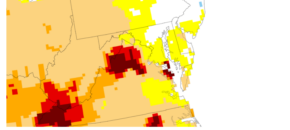Powdery mildew has been reported in cucurbit crops. For more information on the control of CPM please click here. Cucurbit downy mildew has been reported on cucumber in southern New Jersey and Eastern PA. For more information on CDM control please click here. Bacterial leaf spot has been reported in pepper. More more information on […]
Continue reading...Crop progress and sicklebarring palmer greenstalks

Salem County: Two plus inches of June precipitation on the 9th and 12th carried non-irrigated corn and soybean through the month with only trace amounts of precipitation until the 24th when some areas received another half inch. In exceptionally wet fields, climbing humidity levels on the 13th, 14th, and 15th were high enough to allow […]
Continue reading...Identifying white mold in tomato production
White mold, or timber rot, is caused by the soil-borne fungal pathogen, Sclerotinia sclerotiorum. The photo on right shows a high tunnel tomato plant with main stem infected by white mold. Over time the entire plant will slowly collapse looking similar to a wilt or root rot pathogen as the water supply is cut off […]
Continue reading...Tree Fruit IPM Report for June 30, 2022
Peach: Oriental Fruit Moth: A biofix point for OFM was set on 4/11 in southern counties, and on 4/14 in northern counties. The second generation timings are updated below. Insecticide Type County/Region Degree Days by 6/30 base 45 Conventional 1150-1200 1450-1500 Diamide 1075-1150 1375-1450 Gloucester – Southern 1522 1st –past 2nd –past 1st –past 2nd […]
Continue reading...USDA June Acreage Report for Corn, Soybean and Wheat
The USDA released its June Acreage Report Here are the numbers: 2022 Corn Intended Acres: 89.9 million acres compared to the USDA March 31 report of 89.5 million acres and 93.3 million acres in 2021. This would be down 400,00 acres from the March report and down 3.4 million acres from last year. 2022 Soybean […]
Continue reading...Recognizing Angular Leaf Spot in Cucurbits
Angular leaf spot is common in New Jersey and the region. It often shows up during cooler, wet weather and isolated rain. Angular leaf spot will first appear as, small water-soaked lesions which will expand until they reach a larger leaf vein resulting in the angular looking symptoms on […]
Continue reading...